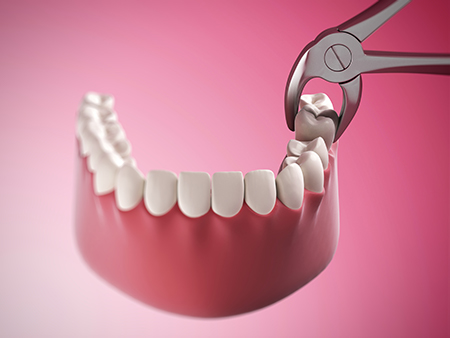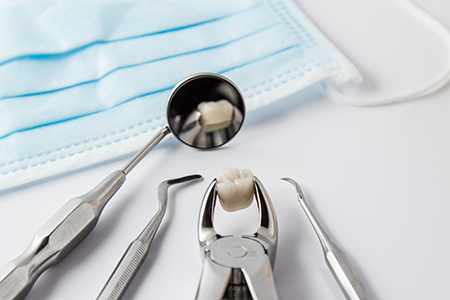
Keeping your natural teeth is always our first goal, but there are clear instances when removal is the safest and most constructive option. Extractions are performed to protect neighboring teeth, resolve infection, prevent damage to developing teeth, and prepare mouths for restorative or orthodontic care. When recommended, the decision is based on a careful evaluation of long-term oral health, not on short-term convenience.
We approach every extraction with a focus on minimizing discomfort and preserving as much oral function as possible. Before any procedure, your dental and medical history will be reviewed so we can tailor care to your needs and any health considerations. If additional specialists or imaging are required, we will coordinate those services to achieve the best outcome.
Our practice emphasizes clear communication: you’ll receive a full explanation of why an extraction is advised, what the procedure will involve, and the options available afterward to restore form and function. This helps you make an informed choice about your care while feeling confident in the plan moving forward.
Primary teeth that are interfering with normal development
Primary (baby) teeth sometimes fail to fall out on schedule because their roots do not resorb properly or because they become fused to the jawbone. When a retained primary tooth blocks the eruption path of a permanent tooth, removal can be essential to allow the developing tooth to come into place and prevent alignment problems.
Teeth damaged beyond repair by caries or trauma
When decay or a fracture has compromised most of a tooth’s structure, conventional restorations may no longer be viable. In those situations, extraction can halt the spread of infection and avoid more serious complications. Our evaluations prioritize conserving teeth when possible, but we will recommend removal when it best protects overall oral health.
Cracked or fractured teeth with irreparable damage
Teeth can sustain cracks that extend into the root or split the tooth in a way that makes predictable restoration impossible. In these cases, extraction may be the most reliable way to relieve pain and prevent further problems for adjacent teeth and tissues.
Advanced periodontal disease weakening tooth support
Periodontal disease progressively destroys the supporting structures of teeth. When bone loss and mobility are severe, extraction can be required to remove a source of infection and to allow the surrounding tissues to stabilize. Removing a hopeless tooth can also simplify subsequent restorative or prosthetic planning.
Impacted or problematic wisdom teeth
Third molars often erupt with limited space, creating impaction, crowding, or chronic inflammation. When wisdom teeth threaten neighboring teeth or repeatedly cause pain and infection, removal is commonly the most predictable route to long-term comfort and oral health.
Teeth removed as part of orthodontic or restorative planning
In some treatment plans, selective extractions create the space needed to achieve proper alignment or to balance dental proportions. When that is the case, extraction is used strategically to improve overall function and esthetics as part of a comprehensive plan.

Every extraction begins with a detailed assessment that may include clinical examination and digital radiographs to define root shape, tooth position, and relationship to adjacent structures. We’ll review any medications you take and any medical conditions that could affect surgery or healing. If necessary, we will coordinate with your physician or recommend additional precautions to keep you safe.
Our goal is to keep procedures predictable and comfortable. We use local anesthetic to numb the area and, when appropriate, can offer sedation options to help patients who experience anxiety or who are undergoing more complex treatment. You will be fully informed about the anesthetic and any recommended pre-surgical steps before the appointment.
During the appointment, the dentist follows a stepwise approach to minimize trauma: gentle elevation of soft tissues, careful loosening of the tooth, and controlled removal. If a tooth is visible and uncomplicated, the process is straightforward and efficient. For more complex situations, additional techniques are used to access and remove the tooth while protecting the surrounding bone and tissues.
Simple extractions apply when the tooth is fully erupted and has a root structure that can be grasped with forceps. After effective local anesthesia, the tooth is gently rocked to widen the socket and remove the root and crown together. Even with a routine extraction, we take measures to keep you relaxed and comfortable, and we’ll explain any options for sedation if you prefer additional support.
Surgical extractions are used for teeth that are fractured at the gumline, ankylosed, or impacted beneath the bone. These procedures may involve a small incision, removal of a portion of bone, and sectioning the tooth to extract it in pieces. In certain cases we may refer you to an oral and maxillofacial surgeon who specializes in these procedures to ensure the safest and most predictable outcome.

Thoughtful aftercare helps reduce discomfort and supports predictable healing. We provide individualized instructions based on the complexity of the extraction, whether sutures were placed, and your overall health. Most patients experience some swelling and mild soreness that improves over the first several days with proper care.
To protect the developing blood clot in the socket, you’ll be advised to avoid activities that create suction in the mouth and to refrain from disturbing the area with your tongue or fingers. Maintaining gentle oral hygiene around the surgical site and following any medication directions helps prevent complications and promotes recovery.
If signs of concern appear — such as increasing pain after the first few days, persistent bleeding, fever, or unusual drainage — contact the office promptly so we can assess your healing and provide appropriate care. Early attention to complications leads to quicker resolution and a better experience overall.
Control bleeding with firm pressure
Bite gently on the gauze we place over the socket for the time we recommend. Replace the gauze as directed until bleeding slows. Some light oozing is normal for up to 24 hours.
Protect numb tissues
Until sensation returns, avoid chewing on the side of the mouth where the procedure was done to prevent accidental bites or injury to the lips, cheeks, or tongue.
Use medications as instructed
If antibiotics or pain medications are prescribed, take them exactly as directed. For many patients, an over-the-counter non-aspirin analgesic taken as needed provides adequate pain control; follow the specific guidance provided by your clinician.
Limit rinsing and avoid suction
Avoid vigorous rinsing, spitting, or using a straw for the first 24–48 hours so the blood clot can form undisturbed. After that, gentle rinsing with warm salt water can help keep the area clean.
Manage swelling and activity
Apply an ice pack intermittently during the first 24 hours to help with swelling. Rest and avoid strenuous activity for a day or two to support healing.
Avoid smoking
Tobacco use interferes with clot formation and slows healing. Refrain from smoking or using tobacco products for at least one week following the extraction.
Eat soft foods and stay hydrated
Choose nourishing foods that are easy to chew and avoid hot or spicy items for the first couple of days. Keep hydrated with water and mild, non-carbonated beverages.
Attend follow-up care
If stitches were placed or if your procedure was complex, we’ll schedule a follow-up to monitor healing and remove sutures if needed. Keeping this appointment helps ensure a smooth recovery.
If you notice persistent or worsening symptoms, contact the office so we can evaluate and provide prompt care. Early communication is the best way to address issues and protect your oral health.

When extractions are necessary, what matters most is predictable technique, careful planning for what comes next, and a team that prioritizes your comfort. Our clinicians use modern imaging, conservative surgical methods, and clear communication to reduce risk and keep you informed at every step.
We emphasize treatment plans that consider both immediate needs and long-term oral function. If tooth replacement is appropriate after extraction, we will outline options designed to restore chewing ability, maintain facial support, and preserve remaining teeth. Our recommendations are focused on outcomes that support lasting health.
Your experience is important to us: from pre-surgical preparation to recovery guidance, we aim to provide respectful, evidence-based care that puts your well-being first. If you have questions about how an extraction fits into your overall dental plan, our team will explain the options and next steps in plain, helpful language.
In summary, extractions are a common, well-understood part of modern dental care when performed for sound clinical reasons. We strive to make the process as comfortable and straightforward as possible while protecting your long-term oral health. Please contact us for more information or to discuss whether an extraction may be the right choice for you.

Extractions are recommended when keeping a tooth would compromise long-term oral health, such as when decay or trauma has destroyed most of the tooth structure, when infection cannot be controlled with other treatments, or when advanced periodontal disease has caused severe loss of supporting bone. They are also indicated for impacted wisdom teeth that cause pain, infection, or damage to adjacent teeth, and for primary teeth that block the eruption of permanent teeth in growing children. In some orthodontic or restorative treatment plans, selective extractions create the space required for predictable alignment and function.
The decision to remove a tooth is based on a careful clinical exam, diagnostic imaging, and a discussion of alternatives like restoration, root canal therapy, or periodontal therapy when those options are feasible. Your dentist will explain the reasons for recommending extraction, outline the expected outcomes, and coordinate with specialists when advanced imaging or surgical expertise is needed. The primary goal is to protect surrounding teeth and tissues while planning for any necessary replacement to preserve chewing function and facial support.
A simple extraction applies to a tooth that is fully erupted and has a root form that can be grasped and removed with dental forceps after effective local anesthesia. These procedures typically involve gentle elevation and controlled forceps removal and are performed in the dental office with minimal trauma to surrounding tissues. Simple extractions are predictable and generally have straightforward recovery instructions.
Surgical extractions are used for teeth that are fractured at the gumline, impacted beneath the bone, ankylosed, or otherwise not accessible by forceps alone. These procedures may require a small incision, removal of a portion of bone, and sectioning of the tooth to extract it in pieces, and they are performed with appropriate anesthesia and tissue management. For complex surgical cases the dentist may refer to an oral and maxillofacial surgeon to ensure the safest and most predictable outcome.
Preparation begins with a thorough review of your medical and dental history, current medications, and any allergies so the clinical team can plan safe anesthesia and aftercare. Bring a complete list of medications and any recent medical records that may affect bleeding, infection risk, or sedation decisions, and follow any preoperative instructions your clinician provides. If you will receive sedation or intravenous medication, arrange for a responsible adult to provide transportation and remain available after the procedure.
Your dentist will let you know whether to take routine medications on the day of surgery and whether any temporary adjustments are necessary in consultation with your physician, but you should never change prescriptions without confirmation from a healthcare provider. Follow fasting instructions when sedation is planned and arrive with questions prepared so your clinician can address concerns about the procedure, anesthesia, and postoperative recovery. Clear communication before the appointment helps reduce anxiety and improves the safety and predictability of the treatment.
Local anesthetic is used in virtually all extractions to numb the surgical area and prevent pain during the procedure, and it is supplemented as needed by nitrous oxide for mild to moderate anxiety management. Many practices also offer oral sedation or conscious IV sedation for patients who experience significant dental anxiety or require more complex surgical care, and monitoring is provided to maintain patient safety. The choice of anesthetic and sedation is based on the complexity of the extraction, your medical history, and your comfort preferences.
Your clinician will explain the recommended anesthetic approach and the expected effects, including how long numbness will last and what to expect after sedation. For patients with certain medical conditions or when deeper sedation is appropriate, the team will discuss options and may coordinate care with an anesthesiologist or surgical specialist. Clear preoperative instructions and medical review ensure that sedation and anesthesia are delivered safely and effectively.
In the first 24 hours you can expect some bleeding, swelling, and mild to moderate discomfort that is usually controlled with prescribed or over-the-counter analgesics and cold therapy. You will be asked to bite on gauze to help form a blood clot in the socket, avoid vigorous rinsing or suction actions, and rest to support initial healing. Swelling typically peaks within 48 to 72 hours and then begins to subside, and normal activities can usually be resumed gradually according to your dentist's guidance.
Over the following week the socket will continue to heal and soft tissue will close over the site, although complete bone remodeling takes longer. Gentle oral hygiene should be maintained around the surgical area without disturbing the clot, and warm saltwater rinses are usually recommended after the first 24–48 hours to support cleanliness. If sutures were placed, a follow-up visit will confirm healing progress and remove stitches if necessary.
To reduce the risk of dry socket, avoid activities that disturb the blood clot such as smoking, using a straw, or vigorous spitting for at least the first several days after extraction. Follow postoperative instructions carefully, take any prescribed antibiotics or anti-inflammatory medications exactly as directed, and maintain gentle oral hygiene to keep the area clean without dislodging the clot. Rest and avoiding strenuous exercise in the immediate postoperative period also support predictable healing.
If you experience increasing pain after the first few days, persistent heavy bleeding, fever, or unusual drainage, contact the dental office promptly so the team can evaluate the site and provide targeted care. Early recognition and treatment of infection or a lost clot lead to faster resolution and better outcomes. Keeping scheduled follow-up visits allows your dentist to monitor healing and intervene early if complications arise.
A single extraction may cause a temporary change in how your teeth come together, and adjacent teeth can drift or tilt into the empty space over time if it is not replaced. These changes can affect chewing efficiency and, in some cases, lead to additional wear or shifting that impacts long-term function. Your dentist will discuss the expected short-term effects and how they plan to preserve occlusion and function during treatment planning.
When tooth replacement is indicated, timely planning helps restore chewing ability, maintain facial support, and prevent undesirable tooth movement. Options for replacing teeth are considered with the goal of reestablishing a stable bite and comfortable function, and the clinician will explain how each option will affect your ability to chew and speak. Thoughtful restorative planning minimizes the likelihood of future bite problems and supports long-term oral health.
Common replacement options include dental implants, fixed bridges, and removable partial dentures, each suited to different clinical situations and patient preferences. Dental implants provide a stable, long-term solution that helps preserve jawbone and supports adjacent teeth, while bridges restore function using neighboring teeth as support, and removable options can be an efficient solution when multiple teeth are missing. The best choice depends on bone volume, the number and position of missing teeth, overall health, and long-term treatment goals.
Your dentist may recommend preserving bone at the time of extraction or planning for grafting to optimize implant placement if that is the preferred restorative path. Advanced imaging and digital impressions are often used to evaluate bone quality and plan restorations precisely, ensuring predictable esthetic and functional outcomes. A personalized treatment plan will outline timing for replacement, pros and cons of each option, and the steps needed to restore your smile and chewing ability.
Extractions can be performed safely for most patients when their medical conditions and medications are thoroughly reviewed and appropriate precautions are taken. Conditions such as bleeding disorders, heart valve issues, diabetes, and certain immune-compromising illnesses may require coordination with your physician, specific antibiotic coverage, or adjustments to medication timing to reduce risk. Your dentist will evaluate your health history and consult with your medical provider when necessary to develop a safe care plan.
Some medications, including anticoagulants and certain osteoporosis drugs, require special planning but do not automatically preclude extractions; instead, the dental team and your physician work together to manage risk. When more complex medical management is needed, the procedure may be scheduled in a setting with enhanced medical support or performed by a surgical specialist. Clear communication and preoperative planning allow extractions to proceed with minimized risk for most patients.
The office of Dr. Aaron Tropmann & Dr. Gary Oyster emphasizes predictable, conservative surgical technique, modern diagnostic imaging, and patient-centered communication to make extractions as comfortable and safe as possible. Our clinicians coordinate care with medical providers and specialists when indicated and offer sedation options and evidence-based aftercare to support smooth recovery. We focus on planning for what comes next, including tooth replacement strategies that preserve function and facial support.
Located in Raleigh, the practice combines experienced clinicians, up-to-date technology such as digital radiography and CBCT when needed, and a team approach to ensure each patient receives individualized treatment. Prior to any procedure you will receive a clear explanation of the plan, anesthesia options, and postoperative instructions so you can make an informed decision about your care. If you have questions about how extraction fits into your overall dental plan, the team will review alternatives and next steps in plain, helpful language.

Ready to book your next appointment or have a question for our team? We're here to help.
Connecting with our team is simple! Our friendly staff is here to help with appointment scheduling, answer any questions about your treatment options, and address any concerns you may have. Whether you prefer to give us a call, send an email, or fill out our convenient online contact form, we’re ready to assist you. Take the first step toward a healthier, brighter smile – reach out to us today and experience the difference compassionate, personalized dental care can make.